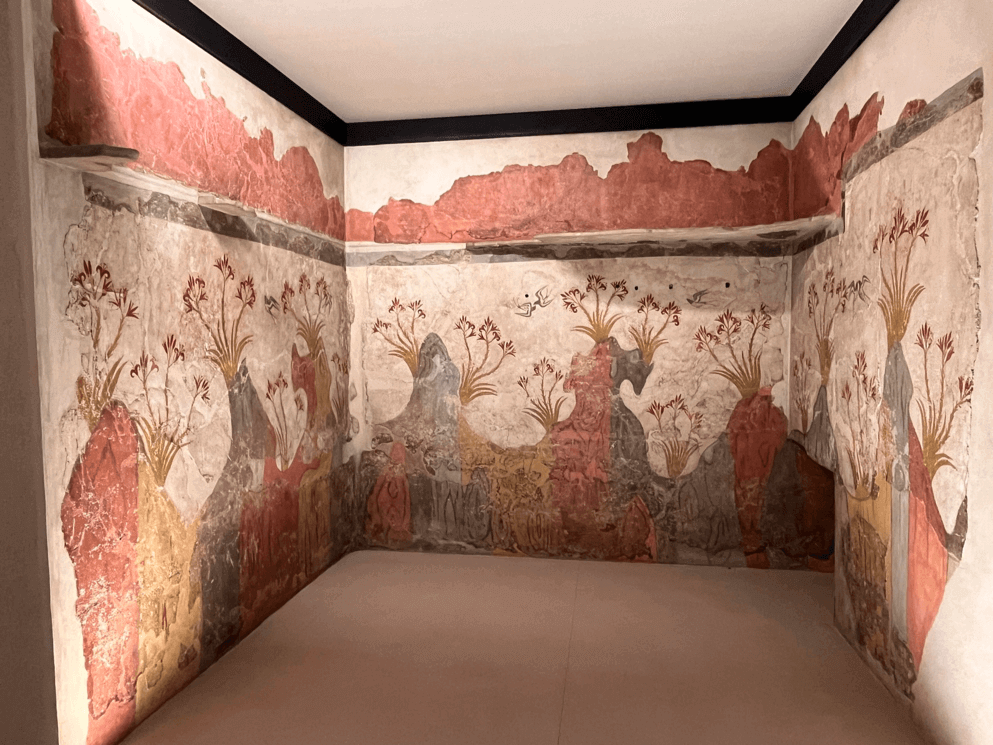The Akrotiri Spring Fresco is a celebrated work of art from the Bronze Age Minoan civilization, found at the town of Akrotiri on the Aegean island of Thera (modern-day Santorini).
It is believed that Akrotiri was destroyed by a volcanic eruption around 1600 BC, but this and many other Akrotiri Frescoes such as the Boxer, Fisherman and Ship Procession Frescoes survived and continues to captivate art enthusiasts and historians alike due to its artistic mastery.
In this article we will delve into the history, interpretations and artistic skill of the Spring Fresco.

Key Takeaways
- The Akrotiri Spring Fresco is a famous work of art from the Bronze Age town of Akrotiri on the Aegean island of Thera.
- The Spring Fresco is a testament to the ancient skill and creativity of the Minoan civilization.
- Despite the destruction caused by the volcanic eruption, the Akrotiri Spring Fresco has survived and continues to be a source of inspiration and wonder for people around the world.
Discovery and Historical Context
Discovered in 1967 in the Minoan city of Akrotiri on the Greek island of Santorini, The Akrotiri Spring Fresco is a well-preserved piece of Minoan art.
The city was buried under volcanic ash from a massive eruption around 1627 BCE, a disaster that paradoxically preserved the frescoes on the walls of almost all buildings in the town.
No human remains have been found at Akrotiri, suggesting the inhabitants may have evacuated in time. The discovery of the Spring Fresco provides significant insight into the Middle and Early Late Bronze Age (20th-17th century BC) Greek civilization.
The Minoan civilization, based on the island of Crete, was renowned for its wealth and advanced technology. Despite eventual decline due to earthquake damage and the eruption of the Thera volcano, the civilization left a rich cultural legacy, as exemplified by the frescoes from Akrotiri. These artifacts are an integral part of Minoan art and culture, providing invaluable glimpses into the life and beliefs of this ancient society.
The Spring Fresco: An Artistic Masterpiece
The Spring Fresco is a centerpiece at Akrotiri, a Bronze Age settlement on the island of Santorini. This three-part fresco adorned three walls in Room Delta 2, presenting a vividly painted landscape teeming with blossoming lilies and soaring swallows.
It was the only wall painting which was discovered in situ , covering 3 walls of the room.
The fresco’s artistic significance lies in being among the earliest examples of artists drawing inspiration directly from their surroundings. The attention to detail is striking, with flora and fauna depicted so vividly they seem to come to life. The use of the triptych format, detailed naturalistic imagery, and vibrant colors makes it a testament to the Minoans’ artistic sophistication.
Interpretations and Symbolism
There are varied interpretations of the fresco, including the theory that the two central swallows might be fighting rather than kissing, introducing a potential layer of tension. The blossoming lilies offer a glimpse into the island’s pre-eruption landscape, embodying the Minoans’ reverence for nature. The painting symbolizes life’s joy and impermanence, highlighting the resilience of art capable of outlasting entire civilizations.
The Spring Fresco: A Cultural Insight
The composition of the fresco, featuring a central tree encircled by a flower-filled garden, is noteworthy. The tree seems to be a saffron crocus, which was highly valued in antiquity for its medicinal properties and use as a spice.
This garden depiction suggests the Minoans’ high regard for nature and demonstrates their advanced understanding of horticulture and botany.
Preservation and Ongoing Research
Preserved by the volcanic eruption of Theran in the mid-second millennium BC, the frescoes remain intact thanks to ongoing preservation efforts since their discovery in the 19th century.
A modern shelter protects the site, preserving the frescoes from environmental damage and regular monitoring ensures their safety from visitor-related harm.
Recent excavations have led to insights into the Minoan civilization and the frescoes. Researchers have found that the pigments used were derived from various natural materials, including ochre, lime plaster, and Egyptian blue.
These findings enhance our understanding of the techniques, materials, and life of the Minoan civilization. Ongoing research is expected to yield even more information about the Akrotiri frescoes and their creators.
Conclusion
In summary, the Akrotiri Spring Fresco stands as a testament to the Minoan civilization’s artistic prowess and cultural values, offering valuable insights into life over 3,500 years ago on the island of Thera. The painting’s survival through the volcanic eruption that devastated Akrotiri underscores its historical significance.
Its vibrant hues, detailed imagery, and emphasis on natural elements manifest the Minoan’s advanced artistic techniques and deep appreciation for nature. The prominent representation of women hints at a possibly more egalitarian society.
This captivating work of art continues to influence and inspire, making it an enduring cultural artifact that bears witness to a rich and fascinating past.
You can explore more about Akrotiri on our blog and dive deeper into the captivating world of Ancient Santorini,
Frequently Asked Questions
What is the significance of the Minoan Springtime fresco from Akrotiri?
The Akrotiri Spring Fresco, discovered in the ancient Minoan city of Akrotiri on Santorini, is a vibrant depiction of a natural landscape. As one of the earliest examples of European landscape painting, it illustrates the Bronze Age Minoan civilization’s artistic prowess and appreciation for nature, serving as a testament to their creativity and sophistication.
Where are the frescoes from Akrotiri?
Frescoes from Akrotiri, preserved after a 17th-century BCE volcanic eruption, are showcased in global institutions like the National Archaeological Museum in Athens, the Museum of Prehistoric Thera on Santorini, and the British Museum in London. As integral parts of Greece’s cultural heritage, these beautifully sophisticated pieces continue to enthrall audiences worldwide.
